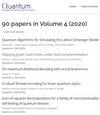Maximum expectation of observables with restricted purity states
IF 5.1
2区 物理与天体物理
Q1 PHYSICS, MULTIDISCIPLINARY
引用次数: 0
Abstract
Assessment of practical quantum information processing (QIP) remains partial without understanding limits imposed by noise. Unfortunately, mere description of noise grows exponentially with system size, becoming cumbersome even for modest sized systems of imminent practical interest. We fulfill the need for estimates on performing noisy quantum state preparation, verification, and observation. To do the estimation we propose fast numerical algorithms to maximize the expectation value of any $d$-dimensional observable over states of bounded purity. This bound on purity factors in noise in a measurable way. Our fastest algorithm takes $O(d)$ steps if the eigendecomposition of the observable is known, otherwise takes $O(d^3)$ steps at worst. The algorithms also solve maximum likelihood estimation for quantum state tomography with convex and even non-convex purity constraints. Numerics show performance of our key sub-routine (it finds in linear time a probability vector with bounded norm that most overlaps with a fixed vector) can be several orders of magnitude faster than a common state-of-the-art convex optimization solver. Our work fosters a practical way forward to asses limitations on QIP imposed by quantum noise. Along the way, we also give a simple but fundamental insight, noisy systems (equivalently noisy Hamiltonians) always give higher ground-state energy than their noiseless counterparts.受限纯度态观测值的最大期望值
如果不了解噪声带来的限制,对实用量子信息处理(QIP)的评估仍然是片面的。遗憾的是,仅仅对噪声的描述会随着系统规模的扩大而呈指数增长,即使是对具有迫切实际意义的适度规模系统而言,也会变得非常麻烦。我们满足了对执行噪声量子态准备、验证和观测的估计需求。为了进行估算,我们提出了快速数值算法,以最大化纯度有界的状态上任何 $d$ 维观测值的期望值。这种纯度约束以可测量的方式将噪声因素考虑在内。如果已知观测值的特征分解,我们的最快算法需要 $O(d)$ 步,否则最差也需要 $O(d^3)$ 步。这些算法还解决了具有凸纯度约束甚至非凸纯度约束的量子态层析最大似然估计问题。数值计算表明,我们的关键子程序(它能在线性时间内找到与固定矢量重叠最多的有界规范概率矢量)的性能比最先进的普通凸优化求解器快几个数量级。我们的工作为评估量子噪声对 QIP 的限制提供了一条切实可行的途径。同时,我们还提出了一个简单而基本的见解:有噪声的系统(等同于有噪声的哈密顿)总是比无噪声的系统具有更高的基态能量。
本文章由计算机程序翻译,如有差异,请以英文原文为准。
求助全文
约1分钟内获得全文
求助全文
来源期刊

Quantum
Physics and Astronomy-Physics and Astronomy (miscellaneous)
CiteScore
9.20
自引率
10.90%
发文量
241
审稿时长
16 weeks
期刊介绍:
Quantum is an open-access peer-reviewed journal for quantum science and related fields. Quantum is non-profit and community-run: an effort by researchers and for researchers to make science more open and publishing more transparent and efficient.
 求助内容:
求助内容: 应助结果提醒方式:
应助结果提醒方式:


